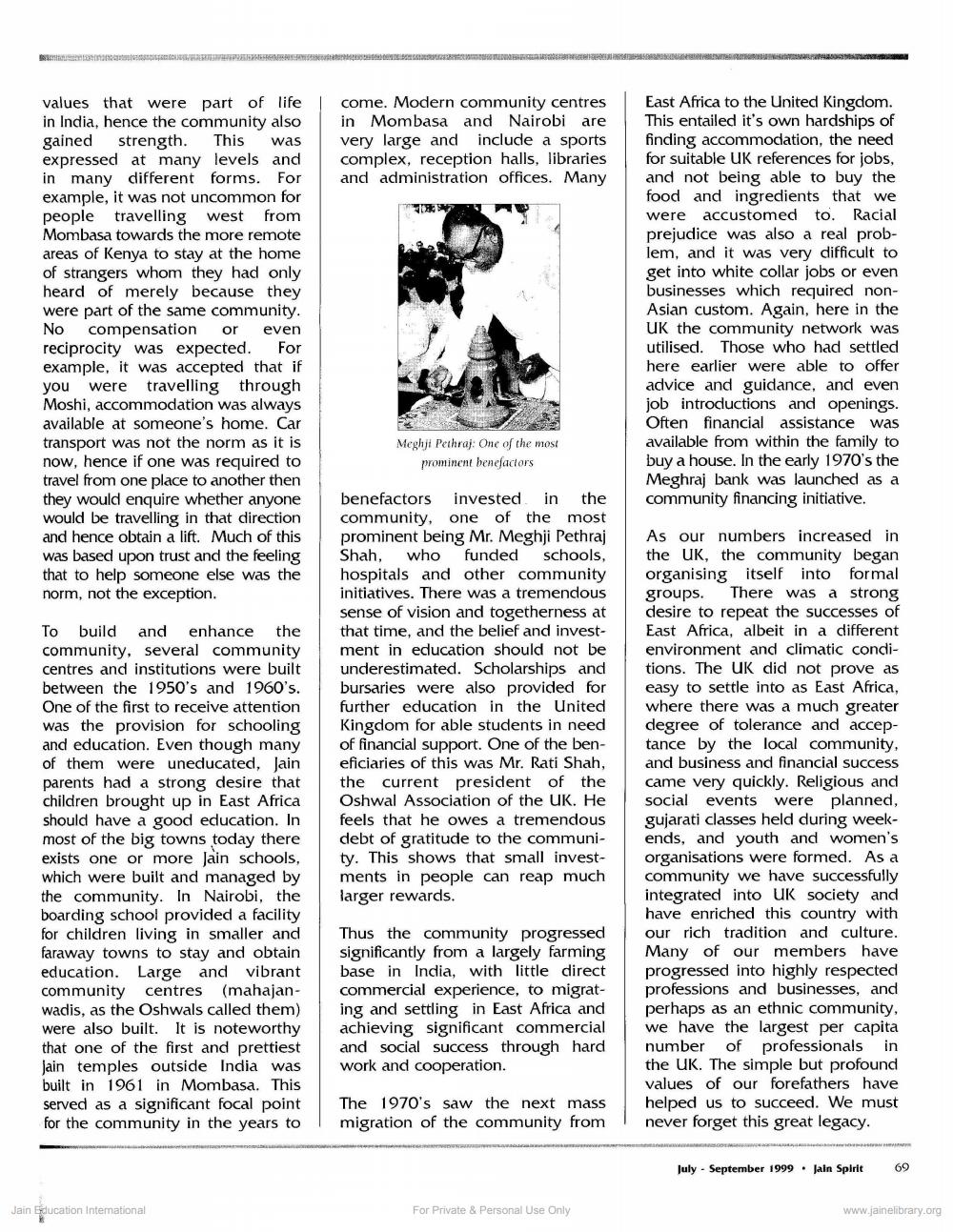________________
values that were part of life in India, hence the community also gained strength. This was expressed at many levels and in many different forms. For example, it was not uncommon for people travelling west from Mombasa towards the more remote areas of Kenya to stay at the home of strangers whom they had only heard of merely because they were part of the same community. No compensation or even reciprocity was expected. For example, it was accepted that if you were travelling through Moshi, accommodation was always available at someone's home. Car transport was not the norm as it is now, hence if one was required to travel from one place to another then they would enquire whether anyone would be travelling in that direction and hence obtain a lift. Much of this was based upon trust and the feeling that to help someone else was the norm, not the exception.
To build and enhance the community, several community centres and institutions were built between the 1950's and 1960's. One of the first to receive attention was the provision for schooling and education. Even though many of them were uneducated, Jain parents had a strong desire that children brought up in East Africa should have a good education. In most of the big towns today there exists one or more Jain schools, which were built and managed by the community. In Nairobi, the boarding school provided a facility for children living in smaller and faraway towns to stay and obtain education. Large and vibrant community centres (mahajanwadis, as the Oshwals called them) were also built. It is noteworthy that one of the first and prettiest Jain temples outside India was built in 1961 in Mombasa. This served as a significant focal point for the community in the years to
Jain Education International
come. Modern community centres in Mombasa and Nairobi are very large and include a sports complex, reception halls, libraries and administration offices. Many
Meghji Pethraj: One of the most prominent benefactors
benefactors invested in the community, one of the most prominent being Mr. Meghji Pethraj Shah, who funded schools, hospitals and other community initiatives. There was a tremendous sense of vision and togetherness at that time, and the belief and investment in education should not be underestimated. Scholarships and bursaries were also provided for further education in the United Kingdom for able students in need of financial support. One of the beneficiaries of this was Mr. Rati Shah, the current president of the Oshwal Association of the UK. He feels that he owes a tremendous debt of gratitude to the community. This shows that small investments in people can reap much larger rewards.
Thus the community progressed significantly from a largely farming base in India, with little direct commercial experience, to migrating and settling in East Africa and achieving significant commercial and social success through hard work and cooperation.
The 1970's saw the next mass migration of the community from
For Private & Personal Use Only
East Africa to the United Kingdom. This entailed it's own hardships of finding accommodation, the need for suitable UK references for jobs, and not being able to buy the food and ingredients that we were accustomed to. Racial prejudice was also a real problem, and it was very difficult to get into white collar jobs or even businesses which required nonAsian custom. Again, here in the UK the community network was utilised. Those who had settled here earlier were able to offer advice and guidance, and even job introductions and openings. Often financial assistance was available from within the family to buy a house. In the early 1970's the Meghraj bank was launched as a community financing initiative.
As our numbers increased in the UK, the community began organising itself into formal groups. There was a strong desire to repeat the successes of East Africa, albeit in a different environment and climatic conditions. The UK did not prove as easy to settle into as East Africa, where there was a much greater degree of tolerance and acceptance by the local community. and business and financial success came very quickly. Religious and social events were planned, gujarati classes held during weekends, and youth and women's organisations were formed. As a community we have successfully integrated into UK society and have enriched this country with our rich tradition and culture. Many of our members have progressed into highly respected professions and businesses, and perhaps as an ethnic community. we have the largest per capita number of professionals in the UK. The simple but profound values of our forefathers have helped us to succeed. We must never forget this great legacy.
July September 1999 Jain Spirit
69
www.jainelibrary.org




